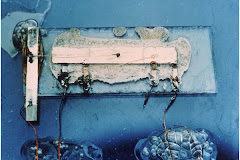Saint Louis University
Book Review
Rebecca Laroche, Medical Authority & Englishwomen’s Herbal Texts, 1550-1650. Ashgate Publishing (Burlington, VT, 2009), 208 pp. ISBN: 978-0-7546-6678-3. $99.95 (USD).
1> Just like the herbal books she writes about, Rebecca Laroche’s task in her work is a large one. Through her meticulous archival work, she has recovered pieces of the most famous herbal books that have not been previously examined. Among the notable textual remarks, she tells the reader that John Parkinson’s Theatrum Botanicum (1640) “weighs eleven pounds,” and in providing a description such as this—the physical heft of the text—she crafts careful arguments about textuality and readership. Part recovery project, part rhetorical analysis, Laroche’s work is the first to analyze medical authority and vernacular herbals in terms of gender.
2> The introduction establishes the context of medical authority within which she writes, and Laroche is clear that the impetus of her work is to “advance our understanding of early modern Englishwomen’s engagement with herbal signifiers and thus medical authority.” Laroche is well aware that the conversation about herbals is not new, but rather than seeking to understand women’s engagement generally, as previous studies have, her research discovers and recovers women such as Anne Wilbraham, “the only actual woman to be named within any English authoritative herbal before 1650.” Women contributed to medical authority as they used and copied the most notable herbals, which were written by men, the most notable of whom being John Parkinson, John Gerard, Robert Dodoens (as translated by Henry Lyte), and William Turner, the “Father of English Botany.” Women are only scantly mentioned in these herbal tomes; however, in uncovering the ways that women engaged with these texts, scholars can understand more clearly the nuanced and complicated issues of medical authority. These issues reach beyond such binaries as entirely hierarchical or “freely practiced,” established or fluctuating. Laroche agrees with Margaret Pelling, who has specifically stated, “Taken as a whole, medical practice in early modern England was neither well organized nor firmly controlled.”
3> In Chapter 1, “‘This Manlike Worke of Herbes’: Gender and the English Herbal,” Laroche takes up the history of herbal print tradition and the anxieties that exist in decidedly gendered language. Laroche understands Anne Wilbraham—who is mentioned in Gerard’s The Herball or Generall Historie of Plantes (1597) as practicing a cure for the ague using “water Dockes” or “bastarde rubarbe”—as a medical experimenter who established the first case of herbal authority. Wilbraham is a “gentlewoman,” however, and not one of “the beggarly rabble of witches, charmers, & such like couseners, that regarde more to get money than to helpe for charitie” for whom Gerard holds disdain in the same Herball. According to this example, medical authority is relegated to gentlewomen, and women—old wives and witches—who aimed to make money were excluded and disparaged by the male herbalists whose works targeted a male audience. Of course, the title of the chapter is derived from Parkinson’s Theatrum Botanicum, who describes his work as “this Manlike Worke of Herbes and Plants,” and thus masculinizes the herbal tradition.
4> In the next section of Chapter 1, “Circe and Malevolent Herbal Practice,” the dedicatory epistle in William Turner’s A New Herball (1551) illustrates the way in which unregulated usage of herbals constituted a danger to establishing legitimacy in medicinal herbals. If women, who were known more often than not as gatherers and keepers of herbal knowledge, became distributors of that knowledge, then a deeper anxiety becomes more visible. Turner decried “old wives” for their oral knowledge, because this orality threatened textual privilege. To the male authors, herbals were meant to “supplant—not facilitate—the knowledge of the ‘olde herbe wives,’ and with the displacement of these old wives will come the domination over all oral preservation of herbal knowledge.” Laroche then connects the trope of the old wives to Homer’s Circe, and this trope returns in Chapter 4, “Isabella Whitney’s Herbs: Print Medical Texts and London Satire.”
5> Chapters 2 and 3, however, focus on the gentlewoman’s role in herbal texts. In Chapter 2, “Inscriptions in Herbal Texts and the Location of Medical Authority,” Laroche begins by reiterating the notion that medical knowledge in the period between 1550 and 1650 was not monolithic but contained variable ways of knowing and practicing medicine, especially by and for women. Herbal ownership takes on a meaning that moves beyond mere physical possession to include possession of textual knowledge. Through this assertion, Laroche demonstrates the social networks that were created through herbal texts. For example, Laroche’s keen archival eye found Elizabeth Bagot’s tentative signature on the bottom margin of the title page of an uncatalogued provenance of Henry Lyte’s translation of Rembert Dodoen’s The Nievve Herball (1578). This signature serves to illustrate the social connections tied to herbals in that Bagot was Lord Burghley, William Cecil’s niece, who was known for his fantastic gardens. The herbalist John Gerard was in fact Cecil’s gardener. Bagot’s own search for knowledge is revealed through a letter written to her husband Walter found in the same archival collection. She writes to him while he is away on business to tell him that she has been perusing his study. As head of household, and thus the household healer, Bagot would have saved money by consulting the Lyte herbal in her husband’s study. Inscriptions, according to Laroche, carried with them a definite sense of audience and were meant to be read in the future; however, each inscription carried with it a different reason, and thus other indicators of authority, such as the following: in Memorium, place, status, education, and her own authority. As herbal signifiers move from “Gerard’s herbal” to “Anne Whitehall’s herbal,” they become even more specifically located within a gendered context.
6> The argument of movable signifiers that began in Chapter 2 continues and becomes even more refined in Chapter 3, “Gentlewoman’s Herbal Readings and the Absent-Present Physicians.” By focusing on the writing and texts of three gentlewomen, Laroche shows the intertextuality, narrative quality and autobiographical elements of such texts. To this end, herbals carry even more gendered authority as they may reveal not only social networks, but also location, temporality and the narrative significance of texts owned and used by these women. As the author suggests: “When Grace Mildmay reads Turner’s herbal and discovers that betony is good for the eyes, she combines it with other such simples to make her own unique eye medicine. When Elizabeth Isham’s sister Judith suffers from melancholia and an agitated and weak heart, Elizabeth makes her a conserve of borage, which we find from the herbals is imbued with curative qualities for such ailments.” Similarly, Margaret Hoby reads of a curative for wounds to aid a workman who has injured his leg. These examples recover and assert women’s authority in herbal medicinal texts, while they complicate the idea of patient and practitioner.
7> Historically salient and rhetorically savvy, Laroche’s archival work extends the conversation on herbal remedies began by historians and literary critics by considering the crucial issue of women’s active involvement in medical practice. Women’s ownership and use of these texts, as illustrated throughout the chapters and numerous visual supplements, figure as a testament to their active participation in herbal healing through the text and not only by way of oral knowledge. As the final chapter also illustrates, women such as Isabella Whitney appropriate their herbal knowledge into verse and satire. The importance of this scholarly work is perhaps best stated by the author when Laroche points toward further studies: “The simple statement of the fact that women practiced medicine in early modern England is not adequate to understanding the nuances of each text, and I hope that this study has presented a model for pursuing the intricacies of the herbal—and perhaps other—language.” Indeed, the work opens the door for subsequent literary, historical and feminist readings of herbal texts to further uncover the intricacies of the tremendous weight of these books.
_____
Sheri L. McCord is Visiting Assistant Professor in English and Medical Humanities at Saint Louis University where she teaches early modern literature, literature and medicine, and Women’s Studies. Her work has been published in English Language Notes, and her current research considers healing and poisoning properties of early modern remedies.
_____
APPOSITIONS: Studies in Renaissance / Early Modern Literature & Culture, http://appositions.blogspot.com/, ISSN: 1946-1992, Volume Three (2010): Digital Archives













No comments:
Post a Comment